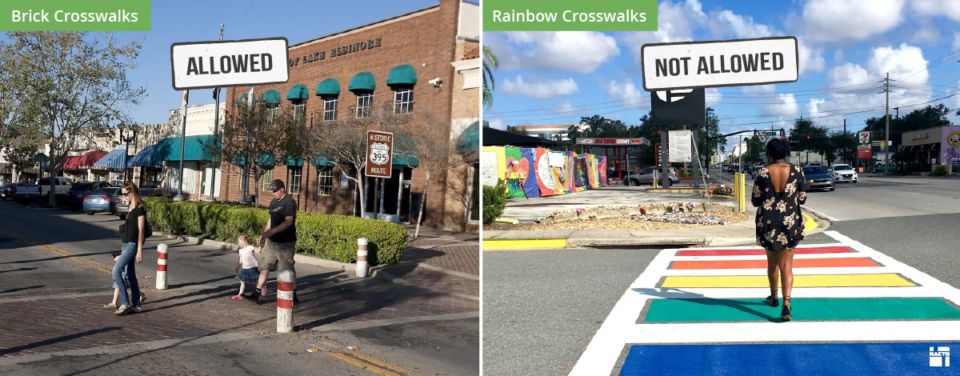
Because of the flawed rules in the MUTCD, American streets are unsafe and unwelcoming, limiting possibilities to create the vibrant, walkable neighborhoods that people want.
The following is a living document that will be updated as city needs and FHWA proposals evolve.
The Federal Highway Administration (FHWA) has broad rulemaking power that guides and impacts the majority of major streets in the United States. In particular, FHWA oversees:
- Manual on Uniform Traffic Control Devices (MUTCD) – the MUTCD sets highly detailed standards for traffic signals, signs, and road markings on all public roads. The MUTCD, along with ADA regulations, is one of the few Federal design standards that applies to all public roads. Learn more about the campaign to modernize these critical federal design standards >>
- National Highway System (NHS) design standards – Under the FAST Act and previous highway legislation in 23 CFR 625, FHWA is responsible for designating NHS standards, which affects Interstates and thousands of miles of urban streets. These standards include AASHTO Policy on Geometric Design of Highways and Streets (the Green Book) and FHWA’s Controlling Criteria. Currently, the NHS design standards include detailed highway design requirements such as clear zones and lane width for high-speed roads, but does not provide a similar ‘floor’ for pedestrian or bicycle safety. The FAST Act specifically directs USDOT to consider the NACTO Urban Street Design Guide in these standards.
Both the NHS design standards and the MUTCD are living documents that require periodic updates to reflect new research on road safety and adapt standards to changing land-uses and development and travel patterns. Both are overdue for an update.
For example, in response to research showing the adverse safety and economic effects of NHS design standards in urbanized areas, FHWA, in a 2015 rulemaking, eliminated most of these ‘controlling criteria’ except for roads designed for 50 mph or higher speeds. However, more remains to be done as the demonstrably unsafe old standard designs are still allowed without requiring a design exception, even in new construction, and most states still use the older standards.
Similarly, the MUTCD was last fully updated in a 2009 rulemaking, with smaller updates in 2012. FHWA has indicated that an MUTCD update is forthcoming and it is expected to improve speed limit guidance and several other areas, but not to address the structure or process issues with the document that lead to lengthy delays between essential updates.
Through NACTO, city transportation practitioners are committed participants in the national design dialogue, including adding city voices as a sponsoring organization of the National Committee on Uniform Traffic Control Devices. Sustained involvement by cities is key to achieving a reduction in traffic deaths and serious injuries while improving access and goods movement in the United States. The following catalogues the recommendations of city transportation experts and practitioners to update and improve FHWA-controlled design guidance for local streets and roadways.
Requested Updates to the Manual on Uniform Traffic Control Devices (MUTCD)
Requested Updates to the National Highway System’s (NHS) Standards & Other Rules
1. Allow cities to use locally adopted design standards on all city-owned streets in the NHS. This may be done by either:
a. Relieving states of their duty to separately conduct design review of FHWA-funded projects on city-owned roads that have already received local approval, or by
b. Requiring that states defer to locally-adopted design standards in reviewing projects on all city-owned streets.
2. Require states to consider locally adopted design standards when constructing or reconstructing roadways in jurisdictions with such standards on the NHS.
3. Adopt a rule to standardize the inclusion of dedicated accessible pedestrian facilities, such as sidewalks, and all-ages bicycle facilities on the NHS, requiring a design exception to construct or reconstruct a roadway without these features. This should apply to all Federal-aid highway projects, pursuant to the existing legal requirement to not adversely impact the safety of non-motorized traffic in a Federally funded project. FHWA’s existing guidance on all-ages bicycle facilities and NACTO’s guidance on the same are acceptable bases for bicycle facility selection.
a. Through MPOs, require states to file a ten-year plan to provide sidewalks and all-ages bicycle facilities on all NHS arterials and collectors in urbanized areas.
b. Establish research-driven national design standards for multi-lane surface roads and urbanized-area roads with speed limits of 35 mph or above that includes maximum acceptable distance between safe crossing points, and a standard of care for pedestrian crossings.